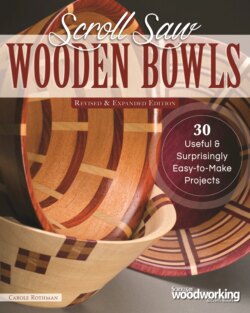Читать книгу Scroll Saw Wooden Bowls, Revised & Expanded Edition - Carole Rothman - Страница 29
Gluing
ОглавлениеOnce the rings are cut, they are stacked and checked for spaces between them. This can be done by shining a light behind the stacked rings or by trying to slip a thin strip of paper between them. If you can see any light, or if the paper slips in at any point, you have a space created by the rings not sitting flat against each other. Even if the blank started out flat, forces released while cutting the rings can result in a slight cupping. If not corrected, even small spaces between adjacent rings can cause unsightly glue lines. Resist the temptation to use clamping pressure to close the gaps. The likelihood that the rings can be forced completely together is small, and it takes little time to correct the problem. The best “tool” for eliminating spaces between rings, often referred to as “flattening the rings,” is a full sheet of 150-grit sandpaper attached to a 12” (305mm) granite floor tile with temporary bond adhesive. Don’t use power sanders for this job; they are too aggressive for finesse work and can quickly ruin your bowl. Identify the areas where spaces show, and apply pressure selectively to the high spots as you rub the ring against the sandpaper. When all rings lie flat against each other, they are ready for glue-up. Remove all pencil marks from the gluing surfaces, but before doing so, relocate any that will be needed to keep the rings aligned correctly during glue-up.
A digital angle gauge helps ensure the accuracy of your cutting angle.
Evenly distributed downward pressure is essential for gluing up rings properly.
